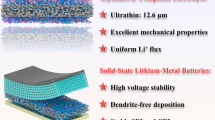Abstract
We report on the effect of the addition of phosphotungstic acid (PWA) in Nafion membrane on ethanol-crossover and the proton conductivity for DEFC application. A set of PWA–Nafion composite membranes (PWA 0, 5, 10, 15, 20 wt%) was prepared by solution casting and their microstructures, diffraction patterns, permeability, and proton conductivity were systematically characterized. The significant reduction in ethanol-crossover is observed with increasing PWA concentration in PWA–Nafion membranes, which is mainly attributed to an improvement in crystallinity of the membrane. PWA provides additional nucleation sites during solidification leading to higher crystallinity, which is supported by the membrane permeability tests. The proton conductivity of the composites is enhanced with PWA concentration until 15 wt% due to an increase in hopping pathways, while higher PWA of 20 wt% leads to a conductivity decrease possibly due to the excessive particle aggregations that limit ion transports. These PWA–Nafion composites were implemented in prototype DEFC devices as a membrane and the maximum power density achieved was 22% higher than that of commercial Nafion-117 device.










Similar content being viewed by others
References
Li X, Faghri A (2013) J Power Sour 226:223–240. doi:10.1016/j.jpowsour.2012.10.061
Sharaf OZ, Orhan MF (2014) Renew Sust Energy Rev 32:810–853. doi:10.1016/j.rser.2014.01.012
Han I-S, Kho B-K, Cho S (2016) J Power Sour 304:244–254. doi:10.1016/j.jpowsour.2015.11.049
Antonucci PL, Aricò AS, Cretì P, Ramunni E, Antonucci V (1999) Solid State Ion 125:431–437. doi:10.1016/S0167-2738(99)00206-4
Kua J, Goddard WA (1999) J Am Chem Soc 121:10928–10941. doi:10.1021/ja9844074
Wen Z, Liu J, Li J (2008) Adv Mater 20:743–747. doi:10.1002/adma.200701578
Zhou W, Zhou Z, Song S et al (2003) Appl Catal B 46:273–285. doi:10.1016/S0926-3373(03)00218-2
Rousseau S, Coutanceau C, Lamy C, Léger JM (2006) J Power Sour 158:18–24. doi:10.1016/j.jpowsour.2005.08.027
Badwal SPS, Giddey S, Kulkarni A, Goel J, Basu S (2015) Appl Energy 145:80–103. doi:10.1016/j.apenergy.2015.02.002
Zakaria Z, Kamarudin SK, Timmiati SN (2016) Appl Energy 163:334–342. doi:10.1016/j.apenergy.2015.10.124
Pethaiah SS, Arunkumar J, Ramos M, Al-Jumaily A, Manivannan N (2016) Bull Mater Sci. doi:10.1007/s12034-015-1130-6
Barbara L, Charya SA, Verna A (2009) Macromol Symp 277:177–189. doi:10.1002/masy.200950322
Battirola LC, Schneider JF, Torriani ÍCL, Tremiliosi-Filho G, Rodrigues-Filho UP (2013) Int J Hydrog Energy 38:12060–12068. doi:10.1016/j.ijhydene.2013.06.126
Maab H, Nunes SP (2010) J Power Sour 195:4036–4042. doi:10.1016/j.jpowsour.2010.01.005
Kozhevnikov IV (1998) Chem Rev 98:171–198
Misono M (1987) Catal Rev 29:269–321. doi:10.1080/01614948708078072
Amirinejad M, Madaeni SS, Navarra MA, Rafiee E, Scrosati B (2011) J Power Sour 196:988–998. doi:10.1016/j.jpowsour.2010.08.062
Saccà A, Carbone A, Pedicini R et al (2008) Fuel Cells 8:225–235. doi:10.1002/fuce.200800009
Bakangura E, Wu L, Ge L, Yang Z, Xu T (2016) Prog Polym Sci 57:103–152. doi:10.1016/j.progpolymsci.2015.11.004
Horan JL, Genupur A, Ren H et al (2009) ChemSusChem 2:226–229. doi:10.1002/cssc.200800237
Horan JL, Lingutla A, Ren H et al (2014) J Phys Chem C 118:135–144. doi:10.1021/jp4089657
Motz AR, Horan JL, Kuo M-C, Herring AM (2015) ECS Trans 69:587–590. doi:10.1149/06917.0587ecst
Xiang Y, Yang M, Zhang J, Lan F, Lu S (2011) J Membr Sci 368:241–245. doi:10.1016/j.memsci.2010.11.049
Yang M, Lu S, Lu J, Jiang SP, Xiang Y (2010) Chem Commun 46:1434–1436. doi:10.1039/b912779h
Malhotra S, Datta R (1997) J Electrochem Soc 144:L23–L26. doi:10.1149/1.1837420
Lu JL, Fang QH, Li SL, Jiang SP (2013) J Membr Sci 427:101–107. doi:10.1016/j.memsci.2012.09.041
Abouzari-lotf E, Jacob MV, Ghassemi H et al (2016) J Power Sour 326:482–489. doi:10.1016/j.jpowsour.2016.07.027
Abouzari-lotf E, Nasef MM, Ghassemi H, Zakeri M, Ahmad A, Abdollahi Y (2015) ACS Appl Mater Interfaces 7:17008–17015. doi:10.1021/acsami.5b02268
Carbone A, Casciola M, Cavalaglio S et al (2004) J N Mater Electrochem Syst 7:1–5
Xu W, Lu T, Liu C, Xing W (2005) Electrochim Acta 50:3280–3285. doi:10.1016/j.electacta.2004.12.014
Mioč UB, Dimitrijević RŽ, Davidović M, Nedić ZP, Mitrović MM, Colomban P (1993) J Mater Sci 29:3705–3718. doi:10.1007/bf00357338
de Bonis C, Cozzi D, Mecheri B et al (2014) Electrochim Acta 147:418–425. doi:10.1016/j.electacta.2014.09.135
Amirinejad M, Madaeni SS, Rafiee E, Amirinejad S (2011) J Membr Sci 377:89–98. doi:10.1016/j.memsci.2011.04.014
Ramani V, Kunz HR, Fenton JM (2004) J Membr Sci 232:31–44. doi:10.1016/j.memsci.2003.11.016
Ramani V, Kunz HR, Fenton JM (2005) Electrochim Acta 50:1181–1187. doi:10.1016/j.electacta.2004.08.015
Lin C, Haolin T, Mu P (2012) Int J Hydrog Energy 37:4694–4698. doi:10.1016/j.ijhydene.2011.04.116
Shang F, Li L, Zhang Y, Li H (2009) J Mater Sci 44:4383–4388. doi:10.1007/s10853-009-3658-6
Wang J, Wasmus S, Savinell RF (1995) J Electrochem Soc 142:4218–4224. doi:10.1149/1.2048487
Mahreni A, Mohamad AB, Kadhum AAH, Daud WRW, Iyuke SE (2009) J Membr Sci 327:32–40. doi:10.1016/j.memsci.2008.10.048
Acknowledgements
The authors gratefully thank the Mid-career Researcher Program (No. 2010-0015063) and Conversion Research Center Program (No. 2011K000674) through the National Research Foundation of Korea (NRF) funded by the Ministry of Education, Science and Technology (MEST) and Basic Science Research Program (No. 2015R1D1A1A01056983) through the NRF, Korea, funded by the Ministry of Education for the financial support. S.L. acknowledges Baylor University faculty startup funds that supported this research. The work at Argonne (S.H., data analysis and contribution to manuscript writing) was supported by U.S. Department of Energy, Office of Basic Energy Sciences, Materials Sciences and Engineering Division. The authors also acknowledge technical support from the K-LAB.
Author information
Authors and Affiliations
Corresponding authors
Ethics declarations
Conflict of interest
The authors declare no competing financial interest.
Electronic supplementary material
Below is the link to the electronic supplementary material.
Rights and permissions
About this article
Cite this article
Kim, H., Lee, S., Kim, S. et al. Membrane crystallinity and fuel crossover in direct ethanol fuel cells with Nafion composite membranes containing phosphotungstic acid. J Mater Sci 52, 2400–2412 (2017). https://doi.org/10.1007/s10853-016-0534-z
Received:
Accepted:
Published:
Issue Date:
DOI: https://doi.org/10.1007/s10853-016-0534-z




